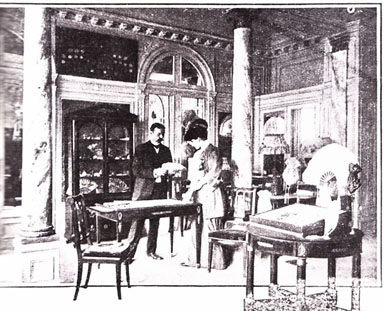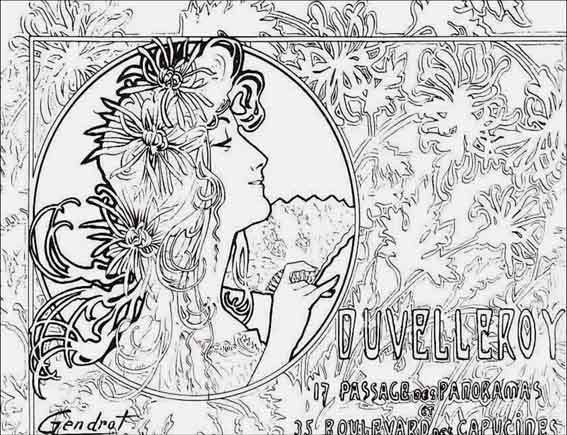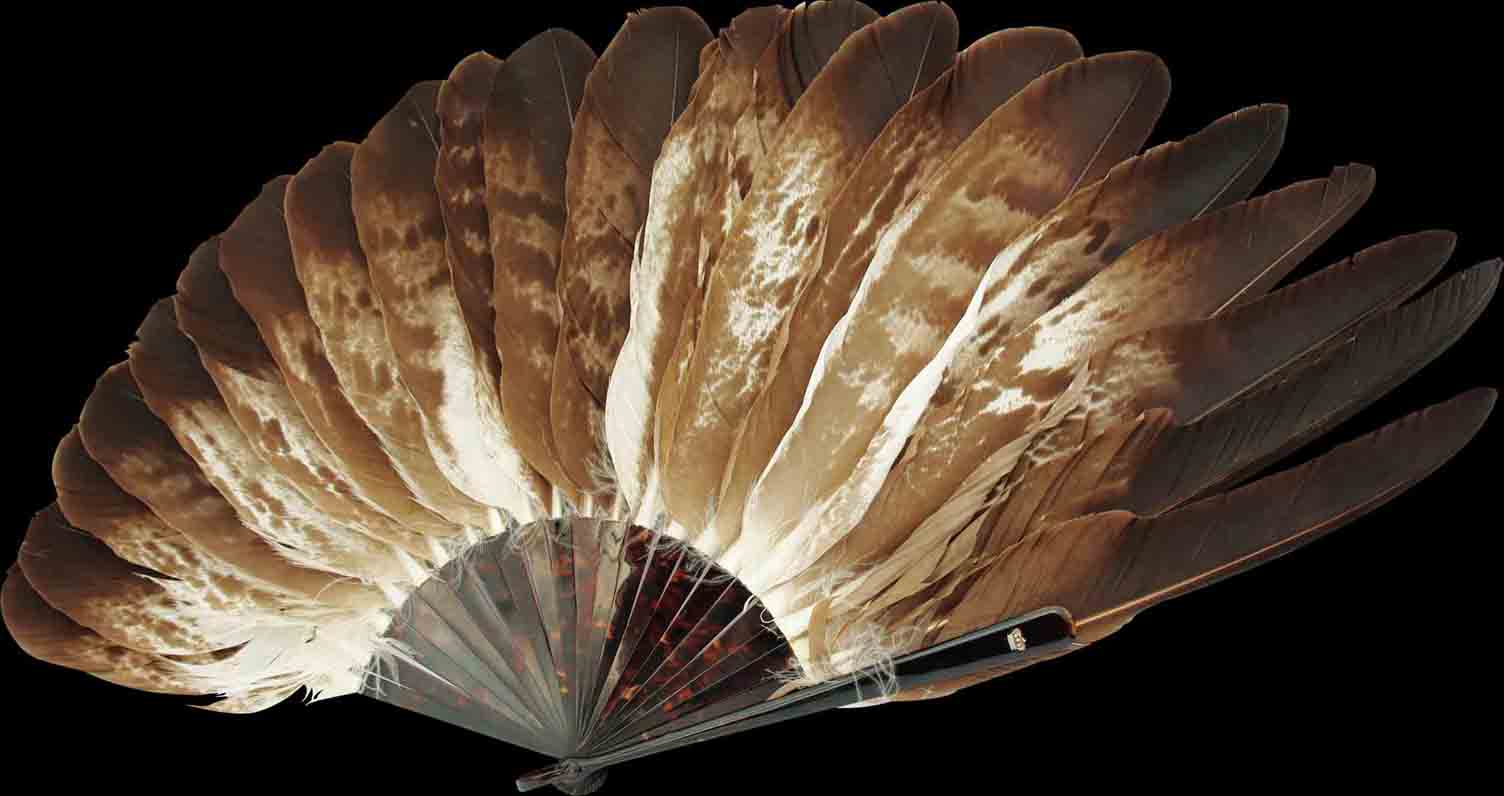Duvelleroy on:
[Wikipedia]
[Google]
[Amazon]
Duvelleroy is a





www.duvelleroy.fr
{{Authority control French companies established in 1827 Fashion accessory companies Clothing brands High fashion brands Art Nouveau Companies based in Paris
fan maker
A handheld fan, or simply hand fan, is any broad, flat surface that is waved back-and-forth to create an airflow. Generally, purpose-made handheld fans are folding fans, which are shaped like a sector of a circle and made of a thin material (suc ...
and leather goods manufacturer founded in Paris
Paris () is the Capital city, capital and List of communes in France with over 20,000 inhabitants, most populous city of France, with an estimated population of 2,165,423 residents in 2019 in an area of more than 105 km² (41 sq mi), ma ...
, France, in 1827 by Jean-Pierre Duvelleroy. It is one of the rare French fan makers still in existence today.
History
Founded in Paris, 1827
For centuries,Paris
Paris () is the Capital city, capital and List of communes in France with over 20,000 inhabitants, most populous city of France, with an estimated population of 2,165,423 residents in 2019 in an area of more than 105 km² (41 sq mi), ma ...
had been the capital of haute couture, high-class jewelry, and fan-making, but in 1827 the city had no more than fifteen fan-makers.Lucie Saboudjian, Ph. John Keyser, ''Ils collectionnent…Les Eventails'', Trouvailles, N°43, Novembre / Décembre 1983 (M2791-43, )
Yet it was at that precise moment that Jean-Pierre Duvelleroy chose to establish his own fan house in Paris. At 25 years old, he was convinced that this small accessory, which had gone out of fashion after the French Revolution
The French Revolution ( ) was a period of radical political and societal change in France that began with the Estates General of 1789 and ended with the formation of the French Consulate in coup of 18 Brumaire, November 1799. Many of its ...
, might become fashionable once again. The demand for fans in South America
South America is a continent entirely in the Western Hemisphere and mostly in the Southern Hemisphere, with a relatively small portion in the Northern Hemisphere at the northern tip of the continent. It can also be described as the sout ...
, which was at the time the primary export market for French fan makers, helped him to start his business.
A ball at the Tuileries, or how fans came back into fashion
Two years later, a special event was to bring him luck: a ball given by the Duchess of Berry at theTuileries Palace
The Tuileries Palace (french: Palais des Tuileries, ) was a royal and imperial palace in Paris which stood on the right bank of the River Seine, directly in front of the Louvre. It was the usual Parisian residence of most French monarchs, f ...
in March 1829. For the quadrille
The quadrille is a dance that was fashionable in late 18th- and 19th-century Europe and its colonies. The quadrille consists of a chain of four to six '' contredanses''. Latterly the quadrille was frequently danced to a medley of opera melodie ...
the women sported fans. A single dance did it all: once again, fans were back.

A prestigious address, 15 rue de la Paix
The house opened a boutique at 15, rue de la Paix, while its ateliers were established at 17, passage des Panoramas in Paris. Duvelleroy chose the Place Vendome neighborhood at the right moment: it was undergoing major changes and would soon become the center of luxury wares and high-class jewelry.Design and production: a pioneer’s work
To produce fan sticks and guards from precious wood, horn, mother of pearl, ivory or tortoise shell, Jean-Pierre Duvelleroy recruited the best stick makers (or ‘tabletiers’), who were traditionally based in the Oise region of France. For the leaves of his fans, he collaborated with the most sought-after engravers and painters, sometimes working with artists such as Ingres or Delacroix for exceptional pieces.Duvelleroy and the Great Exhibitions: time for recognition
During twenty years, the founder of the House of Duvelleroy contributed to many fan related innovations and patents, never sparing his efforts to obtain recognition for the profession. In 1851, willing to defend his vision of the craft, he wrote a letter to Nathalis Rondot, who recorded the fan section at the 1851 Great Exhibition in London. That same year, Duvelleroy was awarded the prize medal atThe Crystal Palace
The Crystal Palace was a cast iron and plate glass structure, originally built in Hyde Park, London, to house the Great Exhibition of 1851. The exhibition took place from 1 May to 15 October 1851, and more than 14,000 exhibitors from around th ...
. From then on, the house would receive many gold medals for its craftsmanship. The Duvelleroys father and son would each be President of the Syndicate of Fan makers. On this account, both received the Légion d’Honneur, the Greatest Order of Merit for in France.

Duvelleroy, fan maker to the queens
After the production of a fan representing the Royal Family of England, based on a painting by Winterhalter, Duvelleroy was appointed supplier toQueen Victoria
Victoria (Alexandrina Victoria; 24 May 1819 – 22 January 1901) was Queen of the United Kingdom of Great Britain and Ireland from 20 June 1837 until her death in 1901. Her reign of 63 years and 216 days was longer than that of any previo ...
, and opened a boutique in London. Soon enough, Duvelleroy fans were sold in all major courts of Europe. In 1853, Duvelleroy realized a fan for the wedding of Eugénie de Montijo to Emperor Napoleon III. Later, the house would be nominated exclusive supplier of the City of Paris. As such, the House of Duvelleroy realized the fans given to the wives of foreign sovereigns and dignitaries coming to Paris for official visits, such as the Empress of Russia, the Queen of Sweden, the Queen of Denmark and the Queen of Bulgaria.
Little by little, couture fans became it-fans: the leaves of such fans were made of tulle, silk gauze, lace or organza and embroidered with sequins; new shapes were born, and feathers worked into marquetry created new motives.
The language of the fan by Duvelleroy
Jean-Pierre Duvelleroy gave the London House to his elder son Jules, born out of wedlock, while he handed over the management of the Paris House to his legitimate son, Georges Duvelleroy. For some time, Jules Duvelleroy developed the house in England, where he published the language of the fan, a whole code supposedly used by women for centuries. According to Duvelleroy leaflets: * Twirling the fan in the left hand means "we are watched." * Carrying the fan in the right hand in front of her face means "follow me." * Covering the left ear with the open fan means "do not betray our secret." * Drawing the fan through the hand means "I hate you." * Drawing the fan across the cheek means "I love you." * Touching the tip of the fan with the finger means "I wish to speak to you." * Letting the fan rest on the right cheek means "yes." * Letting the fan rest on the left cheek means "no." * Opening and shutting the fan means "you are cruel." * Dropping the fan means "we will be friends." * Fanning slowly means "I am married." * Fanning rapidly means "I am engaged." * Touching the handle of the fan to the lips means "kiss me."
Duvelleroy, leather goods manufacturer
Since the origins of the House, Duvelleroy's evening bags, purses and clutches allow the clients to carry around their precious fans with style. When the fans went out of fashion after World War II, Duvelleroy survived thanks to the beautifully crafted evening bags.Duvelleroy and Art Nouveau
The Art Nouveau period was very rich stylistically for Duvelleroy. Fans were adorned with flowers and women, often painted by Billotey, Louise Abbema, or Maurice Leloir. Two icons of the House were born at that period: the “ballon” or Fontange fan, with its rounded shape, and the Duvelleroy daisy trademark stamped on each fan rivet.
Advertising fans in the 1920s
AfterWorld War I
World War I (28 July 1914 11 November 1918), often abbreviated as WWI, was one of the deadliest global conflicts in history. Belligerents included much of Europe, the Russian Empire, the United States, and the Ottoman Empire, with fightin ...
, the production of fashion fans with textile leaves, declined in favour of advertising fans, with paper leaves. Duvelleroy worked with artists such as Paul Iribe (known for his sketch of a mother and her daughter, which became Lanvin’s trademark) and engraver, offering fans as an advertising media for fragrances, high-end hotels and couture houses. Duvelleroy had its advertising fans printed by Maison Maquet
Maquet is a French manufacturer of luxury stationery, leather goods, and art prints, established in Paris in 1841 by the Maquet brothers, Hector and Charles. One of the most renowned Parisian luxury houses, Maison Maquet became official purveyor ...
.
Between the two wars, Duvelleroy couture fans were mainly feathered fans, often made of ostrich, to adorn the ladies of the Roaring Twenties.
Georges Duvelleroy passed on his know-how to Madeleine Boisset, painter and fan maker, while his daughter took over the direction of the company.
1940-1981: the survival of the House of Duvelleroy
In 1940, Jules-Charles Maignan, who used to work at the Parisian department storeGaleries Lafayette
The Galeries Lafayette () is an upmarket French department store chain, the biggest in Europe. Its flagship store is on Boulevard Haussmann in the 9th arrondissement of Paris but it now operates in a number of other locations in France and oth ...
, took over the House of Duvelleroy from the great-grandchildren of the founder. Madeleine Boisset, a lifelong apprentice of Georges Duvelleroy, ensured for some time the continuity of know-how. Until a tragedy befell: her affiliation to the Resistance movement in France was discovered, and she was deported to the Ravensbruck camp. She died in 1945. It is with her that young Michel Maignan, today’s inheritor of the House, discovered the world of fans.
Duvelleroy is one of the only Houses of fans to have survived after World War II
World War II or the Second World War, often abbreviated as WWII or WW2, was a world war that lasted from 1939 to 1945. It involved the vast majority of the world's countries—including all of the great powers—forming two opposing ...
. Little by little, fans left women’s hands to become a collector’s privilege.
After the war, Duvelleroy continued existing thanks to the trade of small leather goods and pouches, as well as by selling and restoring antique fans.

1981-2009: the saving of a heritage
By duty of memory, Michel Maignan conserved the Duvelleroy Fund which his grandfather passed on to him in 1981. This Fund is made of fans, drawings, tools, materials and furnishings kept since the foundation of the House of Duvelleroy in 1827. “I give it to you so that you can make something out of it”, he said. In 1986, an exhibit dedicated to the Fan as a mirror of the Belle ÉpoqueMusée de la Mode et du Costume, ''L’Eventail, Miroir de la Belle Époque'', Ville de Paris, 15 May 1985 was given in Paris: many Duvelleroy fans were exhibited on this occasion. Since then, many publications and exhibits have been developed, referring to Duvelleroy. In 1995, an exhibit in England was entirely dedicated to the House: Duvelleroy, King of Fans, Fanmaker to Kings.2010: a renewed creativity
In 2010, two young women from the luxury and fashion industry became partners with Michel Maignan, in order to redevelop the House of Duvelleroy through the creation of high-end fans.See also
*Fan (implement)
A handheld fan, or simply hand fan, is any broad, flat surface that is waved back-and-forth to create an airflow. Generally, purpose-made handheld fans are folding fans, which are shaped like a sector of a circle and made of a thin material (su ...
Bibliography
* ''"Fan", The Grove Encyclopedia of Decorative Arts'', Edited by Gordon Campbell,Oxford University Press
Oxford University Press (OUP) is the university press of the University of Oxford. It is the largest university press in the world, and its printing history dates back to the 1480s. Having been officially granted the legal right to print books ...
, 2006
* Lucie Saboudjian, Ph. John Keyser, ''Ils collectionnent…Les Eventails'', Trouvailles, N°43, Novembre / Décembre 1983 (M2791-43, )
* Musée de la Mode et du Costume, ''L’Eventail, Miroir de la Belle Epoque'', Ville de Paris, 15 May 1985
* Michel Maignan, “L’éventail, De l’attribut sacré à l’accessoire de séduction”, Demeures & Châteaux, N°36, Juillet/Août/Septembre 1986 (M1512-36)
* Christl Kammerl, ''Der Fächer, Kunstobjekt und Billetdoux'', Hirmer Verlag München, Münich, 1990
* The Fan Museum, ''Duvelleroy — King of Fans, Fanmaker to Kings'', catalogue de l’exposition du 3 October 95 au 21 January 96 au Fan Museum Greenwich, Londres, 1995
* Hélène Alexander, ''Fans'', Shire Publications Ltd., Buckinghamshire, 2002
* Hélène Alexander, Russel Harris, ''Presenting a Cooling Image, Photography by the Lafayette Studio of Bond Street and Fans from The Fan Museum Greenwich'', The Fan Museum, Greenwich, Londres, 2007
* Fabienne Falluel, Marie-Laure Gutton, ''Élégance et Système D'', Paris 1940-1944, Paris Musées, Les Collections de la Ville de Paris, mars 2009, Actes Sud
* Charles Knight, ''The English cyclopaedia'', Volume 4, Page 23, 1867
* Jules Kindt, ''Rapport de la Commission Belge de l’Exposition Universelle de Paris en 1867'', tome II, pages 327-8, Bruxelles, Imprimerie Et Lithographie de E. Guyot, 1868
References
External links
www.duvelleroy.fr
{{Authority control French companies established in 1827 Fashion accessory companies Clothing brands High fashion brands Art Nouveau Companies based in Paris